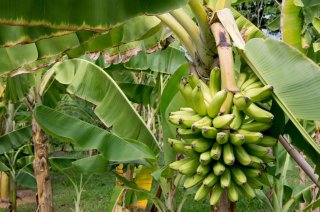
category_news
The crooked world of the banana in a book
The banana is a typical example of modern food production. It is not only a successful but also a vulnerable crop. The new book De Banaan (The Banana) offers a glimpse into banana cultivation, the global trade and the future of this yellow fruit. WUR researchers Gert Kema, a professor of plant pathology, and Fédes van Rijn, a senior scientist of impact evaluation, value chains and food systems, edited the book.
Large, sweet, and, above all, cheap bananas are abundantly available in supermarkets. However, the fruit’s future is far from certain. The book De Banaan paints a picture of the world of the banana and how intensive farming systems impact the lives and well-being of humanity. ‘All things considered, the banana symbolises everything that is right and wrong in the globalisation of agriculture and the challenges our society faces: making our food production chains more sustainable,’ the preface states.
‘After reading this book, bananas will never taste the same’, Kema promises. This is because the book considers the banana from different perspectives. From the perspective of the consumer, the supermarket, the trade sector, the farmer and the researcher.
‘The consumer price should be double what it is now for a fair production chain’, say Van Rijn en Kema. ‘A fair price provides the workers on banana plantations with wages that offer a better standard of living than is currently the case,’ Van Rijn states. ‘Prices within the chain are currently on the rise due to fuel prices for air and sea freight,’ Kema adds. ‘Moreover, the increased need for pesticides also increases the expenses for the farmers. South American bananas we eat have been sprayed at least 40 to 65 times per year, which makes bananas one of the least sustainable crops.’
The same bananas
Without pesticides, most of the bananas currently available in supermarkets would disappear. This is because almost all of the bananas in Europe and over half of the bananas in the world are of the same variety. The Cavendish banana saved the global banana market mid-last century when an unstoppable fungus emerged.
Now, the Cavendish banana dominates the global market, while a new variant of the same devastating fungus emerges. This threat is added to the disease that can be curtailed through spraying. Furthermore, this new fungus also affects local varieties, which could potentially wreak havoc for millions of people, in Africa in particular, for whom the banana is a staple crop comparable to rice, maise or grain.
Threats call for new varieties
Despite the threats, Van Rijn and Kema are confident that bananas will not disappear from supermarket shelves. Consumers can help by buying Fair Trade and organic bananas. But more is required, the authors argue. ‘An end must be put to extreme monoculture. We must find varieties that are insensitive to the fungi that currently occur and breed these into new varieties that are tasty and sustainable’, Kema states. This process may be accelerated through modern research methods. ‘The banana will be very diverse in 2035’, he predicts.
